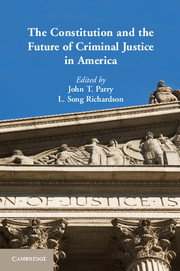Book contents
- Frontmatter
- Contents
- Contributors
- Acknowledgments
- Introduction
- Part I Foundations – The Scope of Criminal Law and Access to Counsel
- Part II Race and Criminal Procedure
- Part III Policing and Privacy
- Part IV Technology and the Surveillance Society
- 8 Information and Social Control
- 9 Is the Fourth Amendment Relevant in a Technological Age?
- Part V Confessions and miranda
- Part VI Conviction, Sentencing, and Incarceration
- Part VII Emergencies and Borders – Immigration, Terrorism, National Security, and Transnational Crime
- Index
- References
8 - Information and Social Control
Published online by Cambridge University Press: 05 June 2014
- Frontmatter
- Contents
- Contributors
- Acknowledgments
- Introduction
- Part I Foundations – The Scope of Criminal Law and Access to Counsel
- Part II Race and Criminal Procedure
- Part III Policing and Privacy
- Part IV Technology and the Surveillance Society
- 8 Information and Social Control
- 9 Is the Fourth Amendment Relevant in a Technological Age?
- Part V Confessions and miranda
- Part VI Conviction, Sentencing, and Incarceration
- Part VII Emergencies and Borders – Immigration, Terrorism, National Security, and Transnational Crime
- Index
- References
Summary
Human societies have long desired to render criminal risk more knowable. While this need was initially met by overt means, such as by the physical branding or mutilation of offenders, in time more bureaucratic, information-based technologies came to predominate. Today, consistent with our increasingly data-driven culture and the need of governments to wean themselves from expensive brick and mortar corrections options, information is assuming unparalleled importance in social control.
The shift is perhaps most evident in the handling of probationers and parolees, who constitute the lion’s share of individuals under active correctional supervision, with governments making increased use of electronic mentoring technologies. Yet information also plays a lynchpin role with individuals “off-paper” (i.e., not subject to active probation or parole conditions), who have paid their penal debt to society.
Perhaps the most prominent example of the latter application is found in government treatment of the hundreds of thousands of individuals for whom a past conviction triggers ongoing supervision as a result of registration and community notii cation (RCN) laws, now in effect nationwide. With RCN, individuals are required, under threat of punishment, to provide and update identifying data (e.g., home/work/school addresses, vehicle information, and physical characteristics such as tattoos or facial hair) to government authorities, for a minimum of ten years and often for their lifetimes. The information is then put to two uses. First, it is maintained by police to allow for the monitoring of registrants and to instill in them the sense that they are being watched, in the hope of deterring possible criminal misconduct. Second, it is provided to the public at large (and worldwide, via the Internet), to augment surveillance and provide community members with information to take self-protective measures vis- á -vis registrants.
- Type
- Chapter
- Information
- The Constitution and the Future of Criminal Justice in America , pp. 137 - 151Publisher: Cambridge University PressPrint publication year: 2013



